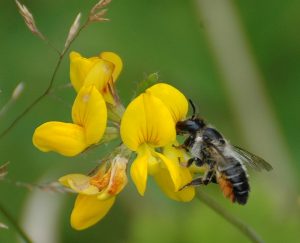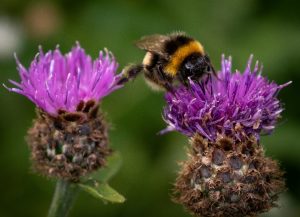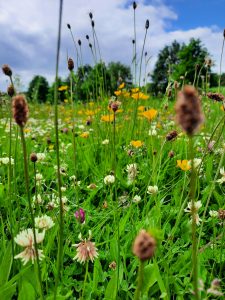Read about this MSc project in Trinity College Dublin which compared ornamental meadows sown with wildflower seed mixes versus biodiversity meadows created by reduced mowing in which no seeds were sown
 Pollinators and urban environments
Pollinators and urban environments
Pollinators are in decline globally, with habitat loss due to changing land use proposed as a major catalyst of this decline. Expansion of urban environments, with increasing areas of land being used for buildings and paving, have drastically reduced the habitat and floral resources available for insect pollinators, and what remains is often highly fragmented. For these reasons, urban environments, such as city centres, were thought to be barren wastelands for wildlife, however, recent research has shifted this vision, highlighting urban areas as places in which wildlife and humans can coexist, if managed correctly. Not only can wildlife co-exist in urban spaces, but due to their huge human populations, such areas have the potential to act as important educational tools to inform and engage their populations about wildlife, and the need to protect it. Understanding how wildlife, especially pollinators, utilise urban spaces can be complex, however. Different species have different tolerances and abilities when it comes to coping with changes in the landscape or increased fragmentation. Pollinators are especially diverse in this respect, with insect pollinators varying greatly in their mobility, dependence on host plant species, and responses to increased anthropogenic activity. Therefore, there is a great need to better understand insect pollinators and their communities within urban environments.
Experimental design
Within Dublin City Centre, the All-Ireland Pollinator Plan’s ‘Actions for Pollinators’ map reveals that there is a network of actions to provide habitat and floral resources for pollinators. The two most frequently occurring within this urban landscape are ‘pollinator-friendly planting’ and ‘reduced mowing.’
- To understand how insect pollinators were utilising these actions, I selected ten sites within Dublin City Centre, and carried out observational surveys to determine their insect pollinator communities, and to understand how these insects were utilising the flowering plant resources available.
- Five of these sites represented ‘pollinator-friendly planting’ as planted meadows, sown with ‘wildflower’ seed mixes, and five represented ‘reduced mowing’ as no-mow meadows, in which no seeds were sown, and the sites were left to regenerate on their own. Both types of site were subsequently managed as long-flowering meadows with one cut per year, usually in September.
No mow meadows support as many pollinators as those sown with wildflowers
The observational transect walks revealed that both planted, and no-mow meadows yielded similar results in terms of the insect pollinator communities that were recorded. The results of the transect walks indicated that bumblebees and hoverflies were more frequently recorded in planted meadows, however, this difference was not statistically significant, nor was there any difference in the overall community composition of insect pollinators between the two types of meadows. Additionally, there were a greater number of plant species identified from planted meadows, which would be expected as usually the seed mixes used include a large species variety, however, again, the difference observed was not significant.
This suggests that reduced mowing can generate varied long-flowering meadows, even within urban environments. The interactions occurring between plants and insect pollinators were also similar for both planted and no-mow meadows, further highlighting the similarity in the results these two types of actions can generate in terms of insect-pollinators.

A bumblebee moves between knapweed while foraging in a long-flowering meadow.
 Doing less may be doing more in terms of providing resources for insect-pollinators within urban environments
Doing less may be doing more in terms of providing resources for insect-pollinators within urban environments
Ultimately, the similarity between pollinator communities of the two meadow types indicates that doing less may be doing more in terms of providing resources for insect-pollinators within urban environments. Simply reducing the mowing frequency to create a mini-meadow within an urban environment can provide resources for insect pollinators, while being cost-effective and less labour-intensive than sowing a site with a seed mix. Opting for reduced mowing also can reduce the risks associated with ‘wildflower’ seed mixes in terms of their potential to introduce new genotypes. Creating mini-meadows by reduced mowing is simple to do, and less work than is usually involved in maintaining a lawn or managing a planted meadow. It may take a bit longer to generate but no-mow meadows can result in diverse plant assemblages and provide plentiful resources for insect pollinators. Such mini-meadows within urban environments can be important for habitat connectivity and reducing fragmentation for insect pollinators, while also providing important floral resources for insect pollinators.
Future studies
The ten sites studied within Dublin City Centre represent only a small subset of the total number of actions occurring for insect pollinators within urban environments. My study highlighted how useful they can be for urban insect pollinator populations but there is lots more to still be determined. These actions do not exist independently from an ecological perspective. Hopefully in the future, further studies will identify the shared benefits such insect pollinator actions have for other forms of urban wildlife, as they have the potential to act as refuges or habitats for birds, small mammals etc. Additionally, understanding the contribution of each conservation action within Dublin City Centre to the overall network of resources available for insect-pollinators is also an important aspect for future study.
Conclusion – Don’t Mow Let it Grow
The number of actions within Dublin City Centre highlights how positive the uptake and engagement has been with the All-Ireland Pollinator Plan. The simple action of reduced mowing can support pollinator communities within urban environments and the greater costs (both economic and labour) of planted meadows do not necessarily translate to a larger benefit for insect pollinators.
Thus, pollinator conservation can be accessible and manageable with relatively little intervention. Benefits can extend beyond insect pollinators to other urban wildlife, but also to the large human populations within city centres, providing important aesthetic and recreational value. This study contributed to a growing body of research which highlights that pockets of biodiversity can exist within urban environments, and in these spaces both humans and wildlife can co-exist. Ensuring the continuation of good uptake, engagement and education will ensure that future generations will experience cities, such as Dublin, as a combination of anthropogenic and natural features, with a more positive outlook of urban environments for nature.
About the author: Emma King is currently a Research Assistant at Trinity College Dublin, and conducted this study, supervised by Prof Jane Stout, as part of her MSc in Biodiversity and Conservation, during 2021.
